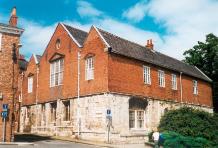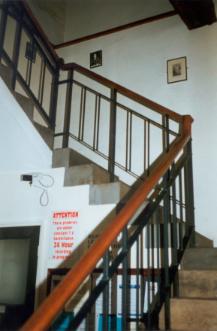Can you tell me about the Borthwick and St Anthony's Hall?
The Borthwick Institute occupied St Anthony's Hall in Peasholme Green for 41 years.
What is St Anthony's Hall?
St Anthony's Hall was built in the mid fifteenth century as the headquarters of a number of religious guilds, one of which was the Guild of St Anthony. The Hall contained a chapel, a "hospital" for aged and sick poor, and a great hall for guild feasts.
In the 16th century the Hall came under the control of the City of York and thereafter it had a variety of uses: including workhouse, "House of Correction" (prison), hospital, school, theatre and a place for archery practice. In the Civil War it was used to store munitions and house wounded soldiers.
In 1705 the Corporation established the Blue Coat School, a charity school for poor or orphan boys in the first floor of St Anthony's Hall, above the House of Correction. Later the school took over the whole of the premises and many further buildings were added. The Blue Coat School closed in 1946 and the Hall was empty until it was renovated in 1951-2 to become the Borthwick Institute.
By that time, St Anthon's Hall comprised a rambling complex of buildings including the medieval guildhall and 18th - 20th century wings arranged around a rear courtyard accessed from Aldwark. At the side was a garden running the full length of the buildings, up to the City walls.
Even in the early 1950s St Anthony's Hall was not ideal accommodation for an archive.
"The conditions in the Hall and its surroundings (there is no object, I think, in not being quite frank) are not ideal: but conditions for a Record Repository hardly ever are, save in the case of a very expensive site and entirely new buildings. Here, as elsewhere, we have to do our best with what is available..."
Sir Hilary Jenkinson, Deputy Keeper of Public Records, 1950

Archive storage in unsuitable conditions
In the early days, the Borthwick Institute occupied only the medieval hall wing, creating searchrooms, strongrooms, a teaching room and offices within it, while the rest of the complex was used for the City of York’s Day Continuation School (this was for young people studying on day release from their employment).
The School moved out in 1968/9 and the Borthwick – by then very pressed for facilities and space – took over some of the vacated buildings: the east wing was converted into a ground floor library with large conservation room above, and a staff room was created in part of the north block.
But the west wing was then leased by the University to York Archaeological Trust who occupied it for more than 20 years. The Borthwick did not expand into the whole of the St Anthony's Hall buildings until 1995.
By then, however, it was clear that the premises were not only unsuitable and inconvenient but they had also become far too small.
After the success of the Heritage Lottery Fund bid and the building of the new Borthwick on a campus site, the Borthwick and the University finally withdrew from St Anthony's Hall at the end of 2004.
The steep stairs up to the
searchroom - there was no liftWhat was wrong with St Anthony's Hall?
The Hall was a rambling building, with narrow corridors, awkward turnings, and few staircases (and no lifts) to link the various levels and wings. Distances between the various parts of the building made working very inefficient. Staff offices were fitted into all parts of the building.
By the 1990s, there were 10 strongrooms, some tiny, but all were full and facilities were far removed from 21st century standards. There was only one, very small, document lift, in the oldest strongroom. There was much physical carrying of documents, and great distances between the newer strongrooms and the searchrooms. One strongroom could only be accessed from outside.
By 2000, the building had not had a thorough overhaul for 50 years, and problems began to emerge – for example, the floor in one of the upstairs offices began to sink and had to be propped up by means of a metal column standing in the middle of the shelving in the strongroom below. As the University contracted its City centre properties, concentrating on King's Manor as its prestigious City presence, the Borthwick became more isolated.
After the Borthwick left St Anthony's Hall it was sold by York City Council to York Conservation Trust (the body whose work was begun by JB and Cuthbert Morrell). After extensive renovations to the Hall complex, the buildings are now occupied by a variety of organisations – a quilting museum, a delicatessen and café, a gallery and studios, and (in a return to premises they occupied before) the York Archaeological Trust. The garden has been remade as a sensory garden, open to the public.



